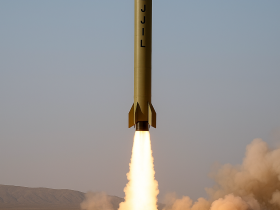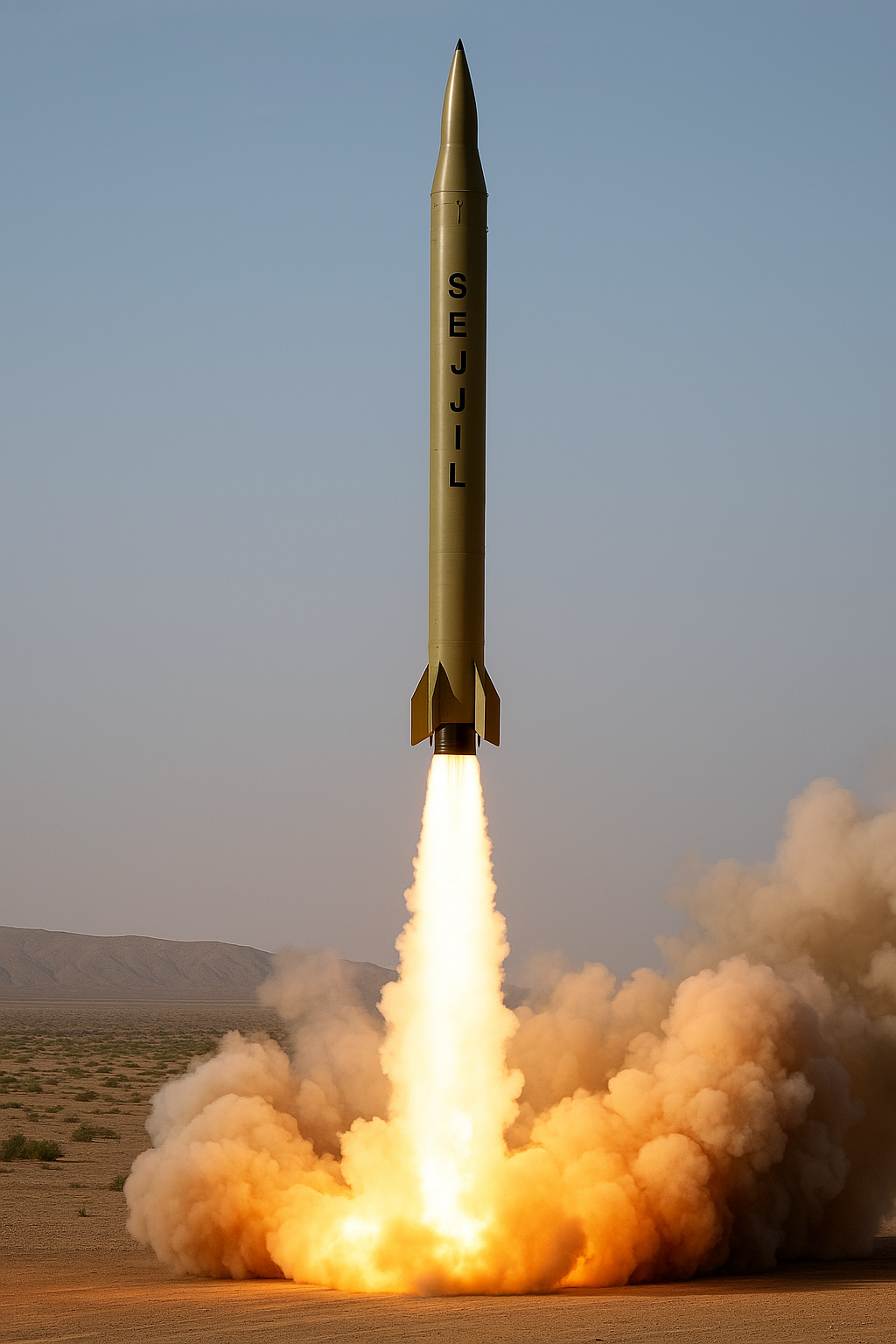The Sejjil (also spelled Sejil) missile represents a significant milestone in Iran’s indigenous ballistic missile development program. As a two-stage, solid-fuel, medium-range ballistic missile, the Sejjil has emerged as a cornerstone of Iran’s strategic deterrent capabilities, offering extended range and enhanced operational flexibility compared to its liquid-fuel predecessors.
Development History and Program Evolution
Origins and Early Development
Development of the Sejjil missile likely began in the late 1990s, building upon Iran’s accumulated experience from previous missile programs, particularly the Zelzal short-range ballistic missile (SRBM) series. The program represented a significant technological leap for Iran’s defense industry, marking the country’s transition from liquid-fuel to solid-fuel propulsion systems for medium-range applications.
The Sejjil program stems directly from Iran’s broader missile development efforts that began during the Iran-Iraq War (1980-1988), when the country faced severe weapons shortages and began developing indigenous defense capabilities. The missile’s development demonstrates Iran’s progression toward more sophisticated, multi-stage missile technologies.
Testing and Deployment Timeline
The Sejjil missile achieved its first successful test launch on November 13, 2008, marking a significant milestone in Iran’s missile program. This initial test validated the missile’s two-stage design and demonstrated its reported range capabilities. The program has seen various iterations and improvements over the years, with testing resuming in 2021 during Iran’s Great Prophet 15 military exercises after approximately a decade of relative inactivity.
Most notably, the missile saw its first reported combat use in June 2025, when Iran’s Islamic Revolutionary Guard Corps (IRGC) employed the Sejjil in strikes against Israel, marking a significant escalation in the weapon’s operational status.
Technical Specifications
Basic Configuration
The Sejjil is characterized by its two-stage, solid-propellant design, measuring approximately 18 meters (59 feet) in length. The missile’s solid-fuel propulsion system offers several advantages over liquid-fuel alternatives, including faster launch preparation times, improved storage capabilities, and enhanced battlefield survivability.
Range and Payload Capabilities
Range: The Sejjil has a reported maximum range of 2,000-2,400 kilometers (1,200-1,500 miles), placing it firmly in the medium-range ballistic missile (MRBM) category. This range capability allows Iran to strike targets across the Middle East, including Israel, southeastern Europe, and parts of Central Asia.
Payload: The missile can carry a warhead weighing approximately 700-1,000 kilograms (1,540-2,200 pounds), providing substantial destructive capability against strategic targets.
Launch Weight: The complete missile system has an estimated launch weight of 18,000-20,000 kilograms for the basic variant.
Advanced Variants
Intelligence reports suggest Iran has developed or is developing more advanced variants of the Sejjil:
- Sejjil-2: An improved version with enhanced accuracy and potentially extended range
- Sejjil-3: A proposed three-stage variant with a reported maximum range of 4,000 kilometers and launch weight of 38,000 kilograms, though this variant’s development status remains uncertain
Mobility and Deployment
The Sejjil is designed for mobile deployment, utilizing transporter-erector-launcher (TEL) vehicles that enhance the missile’s survivability and operational flexibility. This mobility allows for rapid deployment and repositioning, complicating enemy targeting efforts and improving the missile’s strategic value.
Strategic Importance and Military Role
Deterrent Capability
The Sejjil missile serves as a key component of Iran’s strategic deterrent posture. Its medium-range capability allows Iran to hold at risk high-value targets across the region, potentially including military installations, strategic infrastructure, and population centers in neighboring countries.
Technological Advancement
The missile represents Iran’s growing indigenous defense capabilities and technological sophistication. The successful development of solid-fuel, multi-stage missiles demonstrates significant advances in propulsion technology, guidance systems, and manufacturing capabilities.
Regional Power Projection
The Sejjil enhances Iran’s ability to project power across the Middle East without relying on proxy forces or conventional military deployments. This capability contributes to Iran’s regional influence and strategic positioning vis-à-vis both regional rivals and international powers.
Regional Missile Comparisons
Israel’s Jericho Series
Israel’s Jericho missile family provides an interesting comparison to the Sejjil:
- Jericho II: Similar to the Sejjil, this is a two-stage, solid-fuel missile with an estimated range of 1,500-3,500 kilometers
- Jericho III: Represents a more advanced capability with intercontinental range (4,800-6,500 kilometers)
- Technological Maturity: Israeli missiles generally demonstrate more advanced guidance systems and reliability, benefiting from longer development programs and international cooperation
Pakistan’s Shaheen Series
Pakistan’s Shaheen missiles offer another regional comparison:
- Shaheen-II: A two-stage, solid-fuel missile with a 2,000-2,500 kilometer range, closely comparable to the Sejjil
- Shaheen-III: Extended range variant (2,750+ kilometers) with improved accuracy
- Development Cooperation: Pakistan’s missile program has benefited from technological cooperation with China and North Korea, potentially providing advantages in certain technical areas
Comparative Analysis
While the Sejjil demonstrates Iran’s indigenous capabilities, regional competitors may maintain advantages in:
- Accuracy: More sophisticated guidance systems and GPS integration
- Reliability: Longer development and testing programs
- Warhead Technology: More advanced conventional and potentially nuclear warhead designs
- Countermeasures: Enhanced penetration aids and electronic warfare capabilities
International Reactions and Implications
Sanctions and Non-Proliferation Concerns
The Sejjil program has drawn significant international attention and concern:
- UN Security Council Resolutions: The missile’s development has been cited in various UN resolutions concerning Iran’s ballistic missile activities
- Economic Sanctions: Multiple countries have imposed sanctions on Iranian entities involved in missile development
- Technology Transfer Restrictions: International efforts to prevent technology transfer to Iran’s missile programs have intensified
Regional Security Implications
The Sejjil’s capabilities have contributed to regional security dynamics:
- Arms Race Concerns: The missile’s development has prompted neighboring countries to enhance their own defense capabilities
- Deterrence Calculations: Regional powers must account for the Sejjil’s capabilities in their strategic planning
- Alliance Implications: The missile has influenced defense cooperation agreements and security partnerships in the region
Nuclear Proliferation Concerns
While Iran maintains that its missile program is purely defensive and conventional, international observers have raised concerns about potential nuclear applications:
- Dual-Use Capability: The Sejjil’s payload capacity could theoretically accommodate nuclear warheads
- Delivery System Development: Advanced missile capabilities are often viewed as potential nuclear delivery systems
- JCPOA Implications: The missile program has complicated nuclear negotiations and international agreements
Current Status and Future Developments
Operational Deployment
The Sejjil appears to be in limited operational deployment with Iran’s missile forces, primarily under IRGC command. Its first reported combat use in 2025 suggests the missile has achieved operational status, though production numbers remain unclear.
Technological Evolution
Iran continues to develop more advanced missile capabilities, potentially including:
- Improved accuracy through advanced guidance systems
- Enhanced range through propulsion improvements
- Multiple warhead capabilities (MIRV technology)
- Hypersonic variants for enhanced penetration capability
Strategic Integration
The Sejjil forms part of Iran’s broader “axis of resistance” strategy, complementing proxy forces and conventional military capabilities. Its role in Iran’s deterrent strategy continues to evolve as regional tensions fluctuate.
Conclusion
The Sejjil missile represents a significant achievement in Iran’s indigenous defense development program, demonstrating the country’s growing technological capabilities and strategic reach. While facing international sanctions and regional competition, Iran has successfully developed a credible medium-range ballistic missile capability that enhances its deterrent posture and regional influence.
The missile’s development reflects broader trends in regional military modernization and the increasing importance of ballistic missiles in Middle Eastern security dynamics. As Iran continues to refine and expand its missile capabilities, the Sejjil will likely remain a key component of the country’s strategic arsenal, influencing regional security calculations and international non-proliferation efforts.
The recent combat deployment of the Sejjil in 2025 marks a new phase in its operational history, potentially signaling Iran’s willingness to employ its most advanced indigenous missile systems in regional conflicts. This development underscores the weapon’s strategic significance and its role in Iran’s broader defense strategy.
Understanding the Sejjil missile’s capabilities, limitations, and strategic implications remains crucial for defense analysts, policymakers, and regional security experts as they navigate the complex security environment of the Middle East and assess the evolving balance of power in this strategically vital region.








